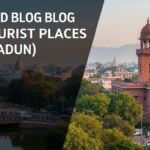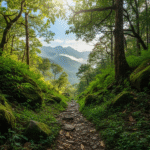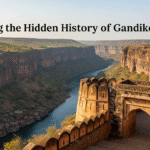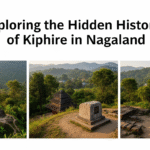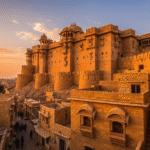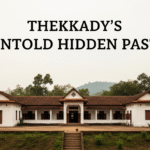India’s history with fortified cities goes back to the 4th century BCE. These cities show the deep roots of ancient military architecture. Yet, many hidden forts in India hold untold stories. They remain unseen by most tourists.
The ‘Arthashastra’ influenced these forts, which include water, hill, and earthen types. They show ancient India’s clever defense strategies. Even after changes in the 16th century, these forts still stand. Their walls keep many ancient secrets.
In India, there are many overlooked forts. From north to south, they showcase India’s history. Unlike popular forts like Mehrangarh or Golconda, these unknown forts invite history buffs. They offer a chance to see the architectural skill and rich stories they hold.
Key Takeaways
- The vast number of unknown forts in India offers an unexplored look into the country’s opulent history.
- The architectural styles and fortress types catalogued by ancient treatises echo through the hidden historical gems of India.
- Medieval fortifications in India reflect a blend of domestic genius and foreign influences, evident in their unique defensive features.
- Rooted in their local landscapes, these forts narrate ancient secrets and historical tales that are waiting to be shared.
- The act of venturing into these lesser-known sites could redefine the cultural and historical understanding of India’s majestic past.
Introduction: India’s Hidden Historical Edifices
India is known for its stunning sceneries and deep history. Its forts tell stories of the past. These offbeat forts reveal India’s true history, holding stories of ancient times.
Exploring Indian forts means entering a world filled with history. Every wall and breeze in these forts tells a tale. They show the blend of architecture and culture through time. Each fort, from the Himalayas to the southern coasts, has its own story.
The Purana Qila in Delhi is one such hidden gem. It tells stories from the Mughal era and other historical events. It’s a peaceful place away from the city’s noise.
| Feature | Description | Historical Significance |
|---|---|---|
| Purana Qila | Founded in 1538, showcasing a blend of Mughal and Surid architectural styles. | Site of multiple historical layers including Mauryan to Mughal periods. |
| Qila-i-Kuhna Mosque | Built in 1541 by Sher Shah, characterized by pointed arches and arched prayer niches. | Represents the epitome of pre-Mughal Islamic architecture in India. |
| Sher Mandal | Intended as Humayun’s personal library, octagonal in shape with steep stairs leading to the roof. | Serves as a poignant reminder of Humayun’s restoration efforts and his intellectual pursuits. |
| Digging into Ancient Civilizations | Excavations revealed artifacts from multiple eras, including Painted Grey Ware culture around 1000 BC. | Sheds light on the continuous human activities and transitions in political and cultural dominions. |
Visiting offbeat forts like Purana Qila is a unique experience. Each artifact tells a tale of the past, inviting guests to discover history. This journey not only adds to your knowledge but also brings awe for India’s rich heritage.
A Dive into Maharashtra’s Past: Daulatabad Fort
The Daulatabad Fort Maharashtra is full of history and mystery. It shows us ancient Indian architecture. The fort has seen many rulers, from the Yadavas dynasty to Muhammad bin Tughlaq. Each left a mark on Daulatabad Fort history.
This secret fort India is close to Aurangabad, just 13 kilometers away. It’s known for its strong defenses and unique design. It’s a great place for anyone interested in ancient forts exploration.
The Architectural Brilliance of Devgiri Fortress
Bhillama Raja built Daulatabad Fort in 1187. It mixes new ideas with old designs to protect the fort. The fort has strong gates and complex mazes. These features show how important the fort was in Maharashtra’s history.
Muhammad bin Tughlaq’s Legacy and the Fort’s Striking Features
Muhammad bin Tughlaq changed the fort’s history when he moved his capital from Delhi. He added stronger defenses and a moat with crocodiles. These helped to stop enemies from getting inside.
Tracing the Best Visitation Times for Daulatabad Fort
The best time to visit the fort is from July to February. This is when it’s cooler and the scenery is beautiful. It’s a good idea to have a guide to learn all the stories and secrets of the fort.
https://www.youtube.com/watch?v=E8pua4rQX_0
In conclusion, Daulatabad Fort is a witness to Maharashtra’s rich history. For those who love travel and history, this fort is a must-see. It offers a deep look into India’s architectural and historical treasures.
A Glimpse of Regal Narwar: Narwar Fort, Madhya Pradesh
Narwar Fort sits on a hill in Madhya Pradesh. It shows the Kachwaha clan’s skill in building. This fort is a strong piece of history and beauty. It tells a special story of the Kachwaha clan’s past.
The design is both strong and lovely. It mixes military and art skills from that time.
The Kachwaha Clan’s Architectural Gem
The Kachwaha clan left their mark on Narwar Fort. You can see their impact in the beautiful columns and arches. These features show their culture and building skills.
Surviving Artistry Amidst Ruins
Time has touched Narwar Fort, but its beauty remains. Walls still show bits of bright paint and glass beads. They tell stories of past glory, much like Gwalior Fort.
This art makes Narwar Fort stand out. It calls to those who love history and exploring.
Ideal Times to Wander through Narwar Fort
Visit Narwar Fort from October to March for good weather. This time is perfect for exploring comfortably. It’s less crowded, making your visit more special.
A visit here offers a peek into India’s lesser-known history. It’s great for anyone who loves learning about the past.
Traveling off the beaten path shows you more of India’s history. Each trip fills in parts of a bigger story still being told.
The Echoes of Lost Grandeur: Bidar Fort, Karnataka
Bidar Fort Karnataka is on the Deccan Plateau. It shows how smart the Bahmanid Dynasty was in making buildings and planning. The fort tells us the story of old Indian forts. It mixes battle-ready designs with culture.
A Peek into the Bahmanid Dynasty’s Masterpiece
The fort was a big deal for the Bahmanid Dynasty. Bidar Fort shows off architectural marvels India. Made in the 15th century, its strong build and fancy decoration are signs of that time’s building achievements.
Rangin Mahal: A Mosaic of Art and Culture
Rangin Mahal is a special part of Bidar Fort. It’s famous for its fine woodwork and colorful tile works. This palace shows the beauty of the past. Many come here to see art and history at Indian forts.
Exploring Gateways and Defensive Structures of Bidar
The beauty of the fort grows because of its Bidar Fort gateways. Big entrances show the Bahmanid Dynasty’s skill in making historic defensive structures. These gateways, along with strong double walls, tell us about old military skill and building genius.
| Feature of Bidar Fort | Description |
|---|---|
| Architectural Style | Indo-Islamic with prominent features from Persian styles as implemented by the Bahmanid Dynasty. |
| Main Attractions | Rangin Mahal, Gumbad Darwaza, Solah Khamba Mosque, and the Royal Bath. |
| Defensive Structures | Five major gateways, double-ring fortification walls, numerous bastions. |
| Cultural Significance | A center of Persian culture and a repository of ancient manuscripts and delicate frescoes. |
Bidar Fort Karnataka is a key part of the area’s history. It draws in historians, architects, and tourists from all over. Visiting the fort helps people really get the greatness of the Bahmanid Dynasty. It shows us why this place is one of India’s true architectural gems.
Flavours of Royalty in Jammu: Dhandidhar Fort
Dhandidhar Fort in Jammu and Kashmir is a piece of Rajouri’s rich past. It was founded by key figures during significant changes. The Dogra rulers took over, showing their strength in both military and building skills.
This fort was a strong military spot and a historic granary of India. Its architecture allowed it to store lots of grain. This shows the smart planning of that time’s leaders.
The Historical Significance of Rajouri’s Governor
Mian Hathu was the governor of Rajouri when the fort was built. He turned a time of trouble into a chance for strength. The fort became a safe place that also stored food.
Military Prowess and Grain Storage within Dogra Stronghold
The fort’s design mixed military strength with smart planning for grain storage. These granaries were key for survival during attacks or bad crops. The fort also offered safety and a good spot for the Dogra rulers in conflicts.
The fort tells a story of Rajouri’s past and smart architecture. Dhandidhar Fort in Jammu and Kashmir stands as a reminder of our history and the clever work of people before us.
Scars of Battles on Stonework: Warangal Fort, Telangana
The Warangal Fort in Telangana is a sight to see. It shows the great work of the Kakatiya Dynasty. It has marks from many battles and tells the history of the area.
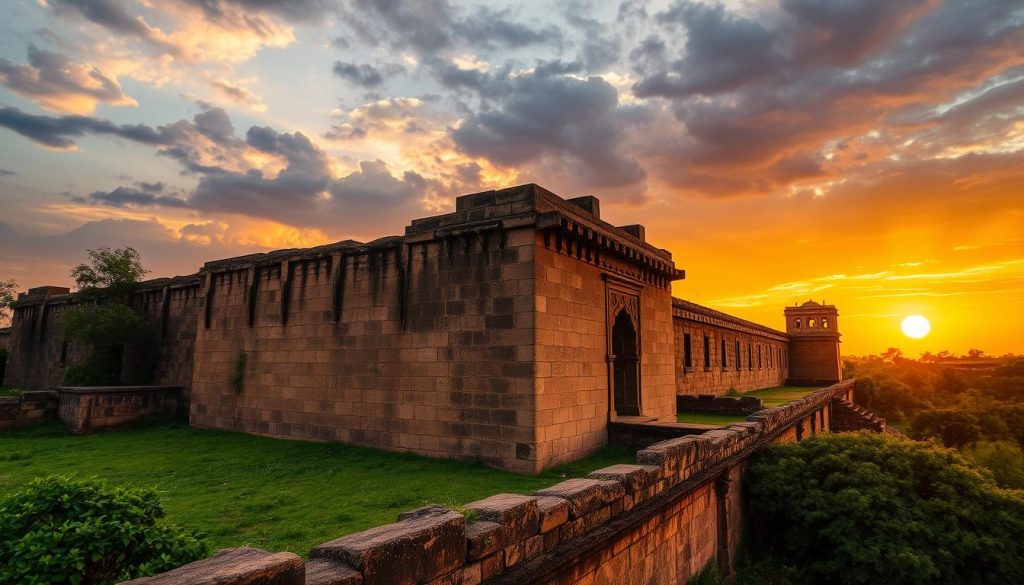
The fort has beautiful gateways and carvings. These details show the legacy of the Kakatiya Dynasty. Warangal Fort is more than an old building. It tells a story of time and faith.
Decoding King Ganpatideva’s Architectural Vision
King Ganpatideva had a big dream for Warangal Fort. It was to be strong and also a place of spirit. The walls are made of mud and granite. This was to protect and also to show beauty.
Kirti Torana: The Gateway to History and Spirituality
The Kirti Torana is a key part of Warangal Fort. It has stood the test of time. It is not just an entrance. It is a path to heritage and faith.
It is decorated with images of Lord Vishnu. The Kirti Torana shares the deep spirituality of ancient India.
Warangal Fort’s remains let us see into the past. It shows us how people lived in a powerful place in India. This fort attracts those who love history and those seeking spirit. Warangal Fort is very important in India’s culture.
Rich History Veiled in Bhatinda: Qila Mubarak, Punjab
Qila Mubarak in Punjab is a big part of India’s history. It is known for its historical significance. This fort is an important ancient fort in India. It draws people who love history and tourists from around the world.
One of the Oldest Forts in India: Qila Mubarak’s Legacy
Qila Mubarak has a long history. It saw many rulers and famous people like Razia Sultana and Prithviraj Chauhan. Its strong walls are part of Bhatinda’s skyline.
These walls remind us of its long past. They are especially important from the Delhi Sultanate time.
This fort has seen a lot of history, including the time of Kushana Emperor Kanishka and Raja Dab. It is famous for its architecture. It was a military fort and a spiritual place with two gurudwaras.
Unearthing the Layers of History in Qila Mubarak’s Dungeons
The Qila Mubarak dungeons have stories of people like Razia Sultana. These stories give us a peek into the past. The dungeons were more than just for defense. They were places that hold many secrets.
Walking through these dungeons is like traveling back in time. They show us the many roles these places had in history.
Now, Qila Mubarak in Punjab is a symbol of beautiful architecture. It attracts people who want to learn about India’s rich history. Keeping this place preserved helps us remember our past. It shares the stories of people who lived there long ago.
“Qila Mubarak stands as a silent yet powerful testament to the confluence of cultures and narratives that have traversed and shaped its corridors throughout history.”
Unveiling Unknown Forts in India
India’s history shines bright with famous forts in Rajasthan and Delhi’s historical walls. But, there are unexplored forts in India with stories not yet told. These hidden forts in India are like quiet guardians of the past. They are also treasures filled with fascinating stories and amazing designs.
The Hidden Gems of Indian Territories
In India, from the chilly North to the sunny South, hidden forts offer new views of history. Take the Kangra Fort, built in the 4th century in Himachal Pradesh. It covers an enormous 463 acres and has secret wells believed to hold treasures. It’s known for surviving many attacks and holding on to its legends.
Lesser-Known Stories from the Corners of Fortified Walls
Each hidden corner has its own unique story, tied to the land it’s on. Places like Bhagat Fort in Rajasthan welcome everyone without an entry fee. Then, there’s the Rosary Church in Karnataka, standing open for the brave and curious. From the widely visited Amber Fort, a UNESCO World Heritage Site, to the less known ruins, each is key to India’s history and architecture.
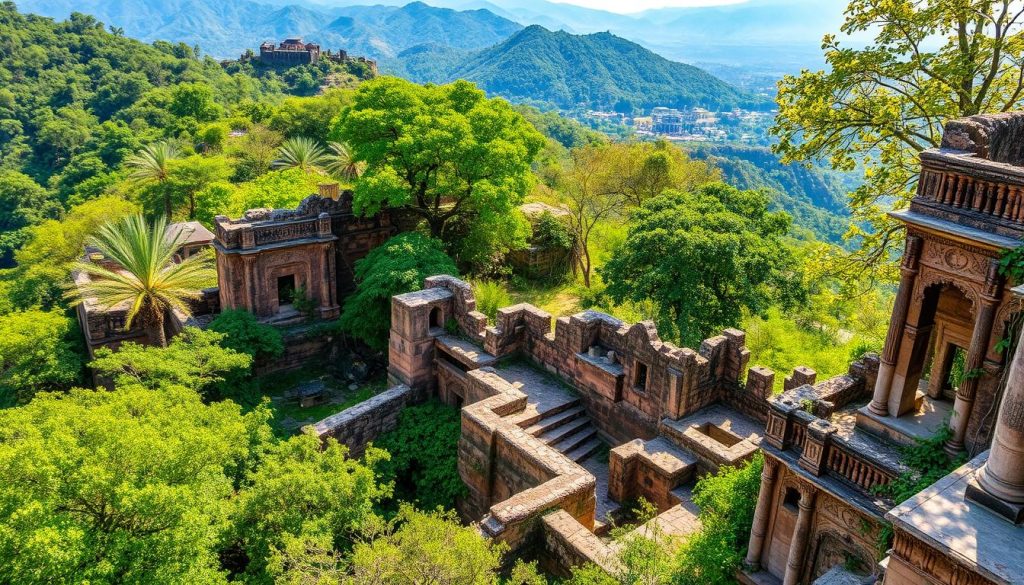
These historical forts are not just beautiful. They show us the political and social ideas of their time. By visiting these secret forts India, we learn about past military and creative skills.
| Fort Name | Entry Fee (Rs) (Indians) | Entry Fee (Rs) (Foreigners) | Location |
|---|---|---|---|
| Raigad Fort | 25 | 300 | Maharashtra |
| Chapora Fort | Free | Free | Goa |
| Bhagat Fort | No Charges | No Charges | Alwar, Rajasthan |
| Rosary Church | No Charges | No Charges | Hassan, Karnataka |
| Ellora Caves | 10 | 250 | Maharashtra |
These unexplored forts in India are more than sights for tourists. They’re pieces of history, each with its own story and importance. They wait for people from everywhere to come, see, and appreciate them.
Intertwined Cultures and Fort Architectures
Indian fort architecture shows a long history of different cultures coming together. The blend comes from Hindu and Muslim influences. These influences are seen in the design and structure of the forts, which were also adapted for war. These beautiful forts tell the stories of India’s past and culture.
The Influence of Hindu and Muslim Styles on Fort Constructions
Forts all over India show a mix of Hindu and Muslim design. For example, Munger Fort in Bihar is where these two styles meet. These forts have Islamic domes and arches as well as Hindu carvings and designs. This mix creates a unique look and tells a story of cultures coming together.
Adapting to Modern Warfare: Developments in Medieval Fort Architecture
Fort designs changed a lot because of new weapons and war strategies. When cannons came into play, forts had to change for better protection. Walls got thicker, and forts were made harder to attack from a distance. For instance, the Red Fort changed a lot after 1857 to defend against modern weapons.
This made forts stronger and added to their cultural stories. They play a big role in India’s history.
| Fort | Architectural Style | Notable Adaptation |
|---|---|---|
| Munger Fort | Hindu-Muslim Fusion | Massive walls and strategic moat |
| Red Fort | Mughal | Reconstruction for barracks post-1857 |
| Taj Mahal | Islamic | Structural symmetry aligning with defensive strategies |
This story of Hindu-Muslim influence and war changes is key to understanding fort design. It helps us see how history shapes buildings and why we should keep them safe.
Conclusion: Preserving India’s Fortified Heritage
Studying India’s fortified history is about more than famous landmarks. It’s about keeping Indian heritage alive by caring for many lesser-known forts. These forts, from Maharashtra’s hill forts to Punjab’s citadels, show India’s defense history and its diverse cultures. Protecting these sites honors India’s long, rich history.
Exploring India’s forts reveals many conservation challenges. These are discussed in “Conserving Fortified Heritage” from a 2015 conference. India faces problems like urban growth, legal issues, and the need for new conservation strategies. To solve these, India must use better management and laws like the Ancient Monuments Act of 1958.
India must keep its unique fort traditions and cultural scenes alive for our future. This means stronger laws and better planning. With wisdom from old texts like the Arthashastra and help from UNESCO, now is the time. India must ensure forts like Narwar and Warangal are celebrated, not forgotten. They are living links to India’s glorious fortified past.
FAQ
What is the historical significance of unknown forts in India?
Unknown forts in India are important because they hold ancient secrets and stories. They help us understand India’s rich history better. These forts tell us about empires and dynasties that shaped the country.
How can travelers explore Indian forts that are off the beaten track?
Travelers can find lesser-known forts like Daulatabad Fort in Maharashtra to explore. Narwar Fort in Madhya Pradesh and Bidar Fort in Karnataka are also great choices. Talking to local historians and taking guided tours can make the trip better.
What are the unique architectural features of Daulatabad Fort?
Daulatabad Fort has a conical hill, multi-layered defenses, Chini Mahal, Chand Minar, and Baradari. Its design shows the cleverness of past rulers. The Yadavas dynasty and Muhammad bin Tughlaq made it really special.
Why is Narwar Fort in Madhya Pradesh considered historically important?
Narwar Fort is important because the Kachwaha Rajputs ruled from there. Even in ruins, it shows grand architecture like fluted columns. It gives us a peek into a grand past, just like other great forts.
What is the best time of year to visit Daulatabad Fort?
Visit Daulatabad Fort from July to February. This time is cooler, and rain makes the visit pleasant. It helps avoid the Deccan’s intense heat.
What makes Bidar Fort a masterpiece of the Bahmanid Dynasty?
Bidar Fort is a masterpiece because of its detailed architecture. The Rangin Mahal shows amazing craftsmanship from the 15th century. Its design, including gateways and double defensive walls, shows its era’s sophistication.
What is unique about the structural adaptations in medieval Indian forts?
As war tactics changed, Indian forts adapted. These changes included making walls lower and thicker. They also added better bastions to fight off attacks, showing how military needs evolved.
What role do lesser-known forts play in the conservation of India’s cultural heritage?
Lesser-known forts help keep India’s cultural heritage alive. They are key to understanding the country’s history. Preserving these forts helps us honor the legacy of the dynasties that built them.

